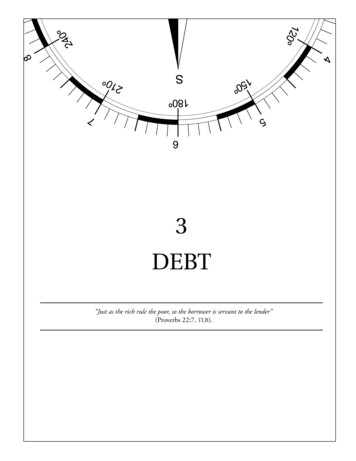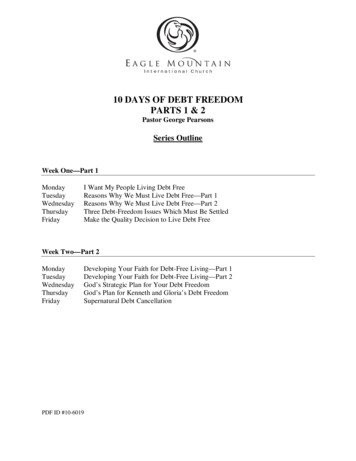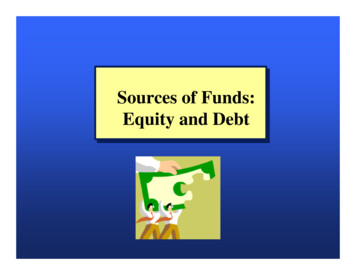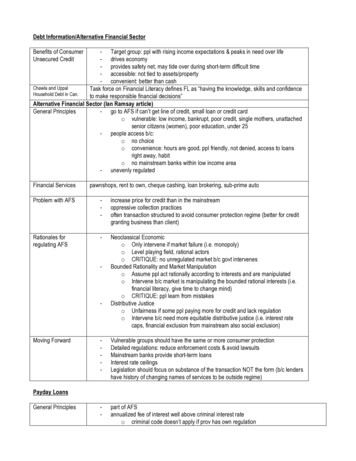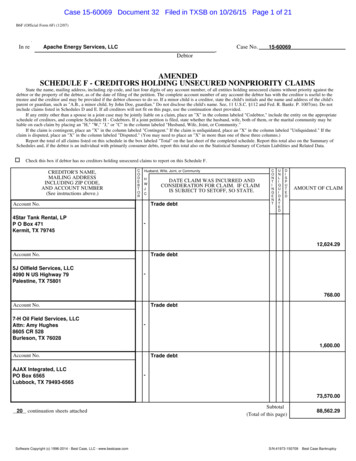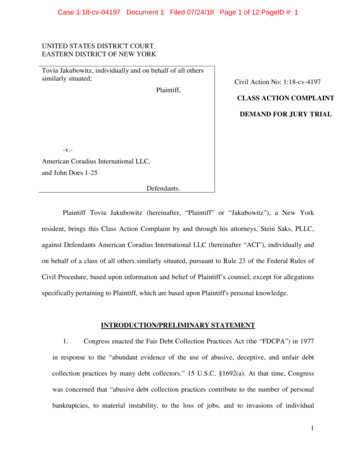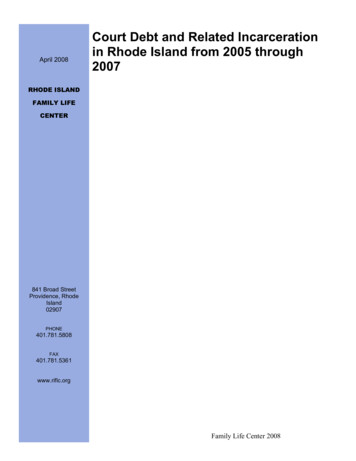
Transcription
Personal Finance: Another PerspectiveDebt:Avoid It Like the PlagueUpdated 2019-09-131
ObjectivesA. Understand our leader’s counsel on debtB. Understand the principles of using debtwiselyC. Know how to develop and use debtreduction strategiesD. Understand and develop a ConsumerLoan and Debt Plan2
Your Personal Financial PlanIX. Student/Consumer Loans and DebtReduction? (Loans and Debt Template LT01-08) What is your vision for consumer/student loansand debt outstanding? What are your goals and your current situation? What is your current debt situation withinterest rates, costs, and other fees? What are your plans and strategies for consumer,student, and other debt? If in debt, what is your debt reduction strategyand views on future debt?3
A Lighthearted Look at Debt4
Case StudyData A family friend has asked you to help one of their childrenwho is having some financial problems. The son came overand gave you the following information. They are marriedand have four children ages 18 to 3 months. Their billsinclude: mortgage 150,000 at 6%, 2nd mortgage 20,000at 7.5% (they took out the 2nd mortgage three years earlierto pay off credit card debt), various financial institutions 10,000 at between 12% an 28% (she lost her job due to thepregnancy), lease on a new truck 18,000, car loan on hercar 5,000, and miscellaneous Christmas bills 3,000. Aftersome work and using LT20, you determined that debtpayments represented 83% of their income for livingexpenses.Application What suggestions do you have to help them get out of debt?5
A. Understand our Leader’s Counsel on Debt J. Reuben Clark said: It is a rule of our financial and economic life in all theworld that interest is to be paid on borrowed money. . .Interest never sleeps nor sickens nor dies; it never goesto the hospital; . . it never visits nor travels; it is neverlaid off work; it never works on reduced hours; it neverpays taxes; it buys no food, it wears no clothes. . . Oncein debt, interest is your constant companion everyminute of the day and night; you cannot shun it or slipaway from it; you cannot dismiss it;. . .and wheneveryou get in its way or cross its course or fail to meet itsdemands it crushes you. So much for the interest wepay. Whoever borrows should understand what interestis, it is with them every minute of the day and night. (J.Reuben Clark, conference address, April 6, 1938)6
Counsel on Debt (continued) We have been counseled for 6,000 years to “Pay thy debt and live” (2 Kings 4:7) More recently, James E. Faust stated: Over the years the wise counsel of our leaders hasbeen to avoid debt except for the purchase of ahome or to pay for an education. I have not heardany of the prophets change this counsel (“Doing theBest Things in the Worst Times,” Ensign, August1984, 41).7
Counsel on Debt (continued) Why is repaying debt so hard? We are not consistent in our thinking. With debt,we borrow an after-tax amount, while withrepayment, we must earn a before-tax amount8
SNL Counsel on Debt (continued)9
B. Understand Principles of Using Debt Wisely Principles 1. Know yourself, your vision and your goals. 2. Seek, receive and act on the Spirit’s guidance. 3. Understand the key areas of debt and know whereyou are financially. 4. Set your goals and resolve to not go into debtexcept for a modest home and education as guided 5. Pay as you go. If in debt add: 6. Prioritize your debts (if you cannot repay them).Give priority to secured debts and immediate needs 7. Develop a repayment plan and automate it 8. Avoid any new debt10
Using Debt Wisely(continued) Principles Know yourself, your vision and goals Seek, receive and act on guidance Understand the key areas of debt Make home/education your only debt Pay as you goIf in debt add: In in debt, prioritize your debts Develop a plan for debt elimination Avoid any new StewardshipStewardshipStewardshipAccountability11
Using Debt Wisely(continued) From Obedience to Consecration I am child of God (identity), living so the Spirit canguide me (obedience), showing what I believe bymy actions, and choosing to delay gratification(accountability). I am using my agency to save forthings and not borrow (stewardship), and learningthe lessons God would have me lean throughdistinguishing between my wants and needs(agency) so I can accomplish my individualmission and individual and family vision and goals.12
QuestionsAny questions on what our leaders have saidregarding debt?13
B. Know How to Develop andUse Debt Reduction Strategies If you never get your first ticket . . .14
Debt Reduction Strategies (continued) What is the process of you (or helping others) gettingout of debt? What should you do? 1. Accept that you have a debt problem. Keep it inperspective 2. Write down your vision and goals so you knowwhere you want to be. Stop incurring new debt 3. See where you are by making a list of all yourbills and debts. Admit the need to change yourhabits and lifestyle if being debt free is important 4. Look for one-shot ways of reducing debt 5. Organize a Debt Repayment Plan, and 6. Follow through on the Plan until total debtelimination15
Debt Reduction Strategies (continued) What are debt reduction (or elimination) strategies? Methods of reducing or paying off debt Why should you understand these strategies even ifyou do not have any debt? You will be working with others who do Are there different types of strategies? a. Personal Strategies: Highest, smallest, replace.Debt Elimination Spreadsheet withAccelerator (LT20) may help b. Counseling Strategies: Consolidation andnegotiation c. Legal Strategies: Bankruptcy16
a. Personal: Expensive Debt First Logic: Pay off your most expensive debts first List all debts and order by highest interest rate Setup a spreadsheet with rows months andcolumns creditors Start with debt with highest interest rate This way you are paying off the most expensivedebt first (and you will be saving the most) Once the most expensive debt is paid off, keeppaying the same amount until all debts are paid off This is the method recommend in Marvin J.Ashton’s “One for the Money” article (see DebtElimination Spreadsheet with Accelerator TT20)17
Expensive Debt First18 18
Debt Elimination: Expensive Debt FirstDebt-Elimination Spreadsheet with Accelerator (LT20)Total DebtTotal Interest PaidTotal Interest and PrincipleMinimum Payments/MonthMonths Paid Off EarlyDate Paid OffTotal Interest Saved 6,212.00 268.026,480.02540.075September 2019 40.47Debt: Credit CardBalance Due -Dentist3. CalculatePiano4. Calculate with Additional PaymentsAuto1,230.00 9.0%7.0%0.75% 50.00 50.00 50.00 50.00 50.00 50.00 50.00 50.00 229.77 229.81-2. Add Debt771.00 16.45 70.02 70.02 70.02 70.02 70.02 179.98 179.98 179.98 0.21-1. Clear FormOctober 2018September 20190.920.421.08%11.92 109.97 109.97 109.97 109.97 109.97Scheduled Payment Amount: 13.0%1.58%4October2018779.00 19.0%Monthly Interest RateOctober 2018November 2018December 2018January 2019February 2019March 2019April 2019May 2019June 2019July 2019August 2019September 2019Department Store423.00 APR# of months to pay offBeginning Month:Beginning Year:Accelerator:Beginning MonthEnding MonthYears to Pay OffYears Paid Early3,009.006.5%0.58%17.29 74.99 74.99 74.99 74.99 74.99 74.99 74.99 74.99 74.99 75.17 304.97 304.97 0.370.54%13.3 235.10 235.10 235.10 235.10 235.10 235.10 235.10 235.10 235.10 235.10 235.10 19 235.10 538.84
b. Personal: Smallest Debt First Logic: Pay of the smallest debts first. Then take themoney saved to pay off all your other debts List all debts, and order from smallest to largest The goal is to pay off the largest number ofdebts as soon as you can If you have additional money, use a payoffaccelerator amount This is an amount over and above yourminimum monthly payments, and apply it toyour first debt payment Target in on one debt at a time until it is paid off.Then continue paying the same amount on yourremaining debts until they are all paid off (LT20)20
Smallest Debt First2121
Debt Elimination: Smallest Debt FirstDebt-Elimination Spreadsheet with Accelerator (LT20)Total DebtTotal Interest PaidTotal Interest and PrincipleMinimum Payments/MonthMonths Paid Off EarlyDate Paid OffTotal Interest Saved 6,212.00 271.116,483.11540.074October 2019 37.38Debt: Credit CardBalance Due Beginning Month:Beginning Year:Accelerator:Beginning MonthEnding MonthYears to Pay OffYears Paid EarlyDentistOctober2018 1. Clear FormOctober 2018October 20191.000.33Department Store423.00 771.00 3. CalculatePiano2. Add Debt4. Calculate with Additional PaymentsAuto779.00 1,230.00 3,009.00APR19.0%9.0%13.0%7.0%6.5%Monthly Interest Rate1.58%0.75%1.08%0.58%0.54%# of months to pay off4October 2018November 2018December 2018January 2019February 2019March 2019April 2019May 2019June 2019July 2019August 2019September 2019October 201916.45 109.97 109.97 109.97 109.97 109.97Scheduled Payment Amount:-11.92 50.00 50.00 50.00 50.00 50.00 159.96 159.96 159.96 122.99-17.29 70.02 70.02 70.02 70.02 70.02 70.02 70.02 70.02 106.99 229.98 2.87- 74.99 74.99 74.99 74.99 74.99 74.99 74.99 74.99 74.99 74.99 302.10 304.97 3.45-13.3 235.10 235.10 235.10 235.10 235.10 235.10 235.10 235.10 235.10 235.10 235.10 235.10 536.62 2.2322
Does it Matter Which Method You Use? Does it matter with method you use? Not really Using pay the highest interest rate first, yousaved 40.47 in interest Using the pay smallest balance first, you saved 37.38 The difference is only 3.09 The important thing is that you DO IT!!!!23
c. Personal: Exchange Secured Debt Home Equity Loans If you have equity in your home, you canconsolidate your debts with a home equity loanwhich will replace your unsecured debt withsecured debt. Is it a good idea? That depends: Have you addressed the original problemwhich got you into debt in the first place? Is your job stable enough so that you couldtake on additional long-term debt?24
Home Equity Loans (continued) Benefits Reduce monthly payments, as rates on secured debt(house) is less than unsecured debt (credit cards) Concerns Interest is no longer tax deductible You may pay more in interest as rates are lower butyou spread payments over more years Experience has shown that 80% of those that takeout a home equity loan are back to where they werein debt within three years. The habit hasn’t changed, the spending willcontinue again, and now they lose both theircredit rating and their house.25
Counseling: Credit Counseling Agencies Counseling Strategies: Credit CounselingAgencies (CCAs) If you are too far in debt, you can get help 3 places 1. Non-profit credit counseling agencies(consolidation) 2. For-profit credit counseling agencies (debtconsolidation and negotiation). Be careful here! 3. Legal help--Bankruptcy Regardless of your choice, check the company outwith the Better Business Bureau before you committo anything26
a. Counseling: Non-profit CCAs What are non-profit CCAs? Agencies set up specifically to help people reducethe credit-card debt load in their lives. What do they cost? Generally, 15-20 for setup and 12 per month How do they work? They have arrangements with many of the creditcompanies are reimbursed 10% of the money youpay to the credit card companies Where can I find them? Call the National Foundation for Credit Counseling(800-388-2227)27
Counseling: Non-profit CCAs (continued) Questions to ask non-profit agencies? What is your tax ID? Are you licensed? Are they members of the National Foundation ofConsumer Credit (NFCC)? Are they accredited through the Council onAccreditation? Are their counselors certified by the NFCC? What is the monthly management fee? Is it taxdeductible? How long will I be in your program? (it shouldnever be longer than 5 years) How much will I be paying each month? (generally,it is taken from a checking or savings account)28
b. Counseling: For-profit CCAs What are For-profit CCA? Companies whose goal is to make moneythrough helping people get out of debt How do they work? Consolidate debt into a single loan with a lowerrate. Get homeowners into a interest-only homeloan and use the excess cash to pay down debt. Work with creditors to reduce the interestrate of certain types of loans, especiallycredit cards. They get rebates, make money on loanorigination and fees, and/or charge retainerfees upfront29
Counseling: For-profit CCAs (continued) Questions to ask: What type of loans will they help you work with?How much will it cost me?How do they make their money?When do they get paid?What is the monthly management fee? Is it taxdeductible? How long will I be in your program? (it shouldnever be longer than 5 years) How much will I be paying each month? (generally,it is taken from a checking or savings account) Will I talk only with one person or many people?30
Counseling: Warning Signs Watch for these warning signs and hang up ifyou sense these: High up-front fees Promises things they cannot deliver (i.e., wepromise creditors will cut the principle owed by50%) Pressure you to sign up for debt-repayment servicesthe moment you call31
Legal: Bankruptcy Chapter 7 Major types of bankruptcy Chapter 7: Liquidates assets and uses them to pay creditorsaccording to precedence in the BankruptcyCode. It is the quickest, simplest and the mostfrequently selected (75%) kind ofbankruptcy filing. Certain debts cannot bewaived by Chapter 7 bankruptcy such aschild support, student loans, drunk drivingfines, etc.32
Legal: Bankruptcy Chapter 13(continued) Chapter 13: A repayment plan in which the court binds boththe debtor and the creditors to terms ofrepayment. The debtor retains property and makesregular payments to a trustee out of futureincome to pay creditors over the life of thebankruptcy plan.33
Legal: Bankruptcy (continued) Interesting facts on bankruptcy 87% of all bankruptcies are due to 3 events: Divorce, death, or separation Unpaid medical expenses Loss of primary source of employment Eliminate the likelihood of these events and youreduce substantially your chance of filingbankruptcy34
Bankruptcy (continued) Questions when thinking about bankruptcy Is it honest? Is it just a way to get out of debt legally? Things that are legal may not be honest. Remember your integrity is worth more thanmoney Is it really necessary? It will remain on your credit report for up to 10years after you make your last payment It will hurt your chances to get the creditnecessary for the purchase of a home or business35
Bankruptcy (continued)L. Aldin Porter said:Utah is the number-two state in the nation "for per-capita bankruptcyfilings“. . . What an indictment of those of us who live in Utah! . . .Our bankruptcy law is on the books for the rare occasion when truedisaster strikes a family, and none of us would take away thatprotection. But I'll also tell you it cannot function as it ought in asociety with overextended and, frankly, somewhat dishonest people.The editorial goes on to suggest that the majority [in Utah] are notusing chapter 13, [which] permits the applicant to repay his debts overa longer period of time. . . Instead, [60%] applied for chapter 7, whichpermits one to break his promises . . . and walk away from his debts,leaving his obligations forever unpaid. . . There is a question asked ofthose who seek a temple recommend that deals with honesty. Isincerely hope that those who have taken unfair advantage of this justand proper law don't carry a temple recommend and feel that they're36absolved from responsibilities (Devotional address given February 4,2001 at BYU).
C. Understand and Create youConsumer Loan and Debt Plan If you are out of debt, we are pleased andimpressed. It is not an easy thing For those in debt, your Consumer Loans and DebtPlan will consist of four areas: Consumer loans (including auto loans) Student loans Other debt Debt reduction strategies (if in debt) Views on future debt37
Consumer Loans and Debt Plan (continued) Start with your views on debt. What are they?Views on Debt I will keep an emergency fund of 3-6 months at alltimes. When I use these, I will repay them in 6 months I will avoid debt except for a home and education, andwill pay cash for all transportation purchases and toys I may need to borrow for my first car. If so, I will pay itoff within 3 years and pay cash for all future vehicles I will save money for my children’s education andmissions by saving 20 per child per month so I will notneed to go into debt for these things I will save 20% of my income and will invest wisely. Iwill get the company match, save 15% of my income forretirement. I will not borrow against my 401k!38
Consumer Loans and Debt Plan (continued) Vision From your “Plan for Life” Goals We will always live on a budget and save 20% We will shop around for best rates on necessary debtand avoid unnecessary debt like the plague Consumer Loans. We will never go into debt forconsumer products, including autos Student loans. We will only use subsidized Studentloans and will repay them quickly39
Consumer Loans and Debt Plan (continued) Plans and StrategiesConsumer Loans We will separate needs from wants We pay cash for all consumer purchases We will pay off all credit cards monthly We avoid debt like the plague We keep our emergency fund at 4 months andrebuild it quickly once it is drawn down We defer all wants until we can pay cash for them We may have to borrow for our first car, but afterthat, we will pay cash for all transportation needs We will never buy toys with debt40
Consumer Loans and Debt Plan (continued) Plans and StrategiesStudent Loans We will spend loan money only on education We will seek scholarships as much as possible We defer all wants until we can pay cash for themand after we have paid off our student loans We will not buy toys until our student loans are allpaid off We will understand our employment options to helppay off our student loan debt We build our emergency fund to 3 months and thenuse the 20% to pay down non-subsidized and then41
Consumer Loans and Debt Plan (continued) Plans and StrategiesDebt ReductionAfter school, put enough in the 401k for the match,then save 20% to build our emergency fund. After that, I will use 20-30% to pay off debt asquickly as possible paying the highest interest ratefirst (LT20). Once debt is paid off, continue to pay20% into savings Continue to live like a student after college, buildmy emergency fund, then pay 20% each monthagainst my debt using the debt snowball methoduntil debt is all gone. Pay more than your minimum payments on debt42
Consumer Loans and Debt Plan (continued) Plans and Strategies One-off Debt Reduction StrategiesIncrease your debt repayment %. Pay more, and use30-50% of income to get out of debt.Call the credit card company and request a lowerinterest rate. This can reduce your interest costs. Ifthey will not do this, move your balances to anothercard that has a lower interest rate (but make suretransfer fees are low)Use savings to pay down debt. Use savings to payoff debt after you have your Emergency FundUse any salary increase to pay down debt. Live atyour previous salary and use increases to pay debt43
Consumer Loans and Debt Plan (continued) One-off Debt Reduction Strategies (continued)Use your tax refund check entirely to pay down debtExchange consumer debt for mortgage debt but onlyif you have equity in your home and you havechanged your spending habitsSell assets. Have a yard sale and sell those thingsyou probably should not have bought in the firstplace to reduce your debtLook for ways to put more money against debtsTry to settle with creditorsGo through credit counseling44
Consumer Loans and Debt Plan (continued) Constraints Key is living on a budget and saving 20%. We will stay strong in the gospel, keeping ourcovenants, attending the temple and serving One half of all unexpected money (bonuses, taxrefunds, etc.) will be put toward paying down debt(after our emergency fund). Accountability We will share our vision and goals with our children Children will have daily and weekly indoor jobs, aswell as weekly yardwork. Home is where we teach our children to work.45
Review of ObjectivesA. Do you understand our leaderscounsel on debt?B. Do you understand the principles ofusing debt wisely?C. Do you understand how to develop anduse debt reduction strategies?D. Do you understand and can you createyour Debt Reduction Plan?46
Case Study #1Data A family friend has asked you to help one of their childrenwho is having some financial problems. The son came overand gave you the following information. They have fourchildren, ages 18 to 3 months. Their bills include:mortgage 150,000 at 6%, 2nd mortgage 20,000 at 7.5%(they took out the 2nd mortgage three years earlier to pay offcredit card debt), various financial institutions 10,000 atbetween 12% an 28% (she lost her job due to thepregnancy), lease on a new truck 18,000, car loan on hercar 5,000, and miscellaneous Christmas bills 3,000. Aftersome work and using LT20, you determined that debtpayments represented 83% of their income for livingexpenses.Application What suggestions do you have to help them get out of debt?47
Case Study #1 Answers The above was a real case that occurred in afew years ago Following was my process to help Please know there are other ways to help as welland that this is not the only way Notice that the topics and order that I helped teachthis couple are the topics and order that I teach inthis class Through thought, prayer, and the guidance ofthe Spirit, you will know what to do to help48
Case Study #1 Answers (continued) 1. Help them to catch their vision of wherethey want to be I shared with them the importance of perspectivethat personal finance is just part of the gospel ofJesus Christ I shared with them the “why’s” and “what’s” ofpersonal finance, why the Lord wants us to befinancially secure They recognized they had a debt problem. Theywere sick and tired of being sick and tired49
Case Study #1 Answers (continued) I encouraged them to do the things they shouldbe doing, their daily conduct on the journey They resolved to come back to Church and be moreactive They started back having family home evening They began working on family scripture study50
Case Study #1 Answers (continued) 2. Help them determine what was important tothem with their goals We helped them think through the process ofsetting effective goals from their vision, and thenthey wrote down their goals so they would beworking for the right things We didn’t spend a lot of time together on thisarea, but we did emphasize its importance andhad them do it on their own Be careful as they have to be working towardtheir goals—not yours They stopped incurring new debt51
Case Study #1 Answers (continued) 3. Help them realize where they werefinancially and that their habits are not takingthem toward their goals We developed a balance sheet for the family We determined what assets were available andowed on each asset – truck, motorcycle, etc. We developed an income statement and ratios We worked at finding out how much wasavailable and where it was going They knew they had to change to reach their goals We put the family on a very strict budget We did leave a little for a date on Friday though52
Case Study #1 Answers (continued) 4. Determine one-off ways of reducing debt We tried to find one-ways to pay off debt We had them fill out their income taxes quicklyfor an early income tax return (January) We borrowed money against their cash-valueinsurance policy to reduce assets We had them sell assets that they could dowithout, i.e. the leased truck, motorcycle, andold vehicles, etc. We talked about yard sales, car sales, oranything else they could do to raise funds53
Case Study #1 Answers (continued) 5. We helped them organize a debt reductionplan, and committed them to that course ofaction We used Debt-Elimination Spreadsheet withAccelerator (LT20) to prepare a debt reduction planand then we worked on that plan together We got other people involved to help them withtalking to creditors and paying off their debts We worked with family, friends, and enlisted theirhelp to work with this couple54
Case Study #1 Answers (continued) 6. We helped them follow through with theirplan (until total debt elimination*) We worked together on their debt reduction plan(not our plan) and held them accountable for it We met with them weekly to see how they weredoing and to encourage them to stick with the Plan We continued to offer encouragement and supportin a non-judgmental manner55
Case Study #1 Answers (continued) Now, five years later, they are still in debt, but itis much more manageable and they are workingto get it all paid off Was it easy? No. Was it worthwhile? Yes. Are they doing better with both their temporal andspiritual goals? Definitely. The wife shared: “I just didn’t realize that itwould be so hard for so long. You run into debt,but you crawl out of it!” *My mistakes (what I would change) I should have worked longer with them56
Case Study #2Data Emilee has been thinking about how much she has toearn to pay back her loans once she leaves school.Assume she will be in the 25% Federal tax bracket afterschool, living in New York (10% state tax rate) andNew York City (5% city tax rate), and she pays 12%gross of her income to charity.Calculations How much must she earn to pay back 1.00 in studentloans (this assumes 0% interest)?57
Case Study #2 AnswerCalculations To pay back 1.00 in loans:Pre-tax Amount to Earn to Pay BackEach Dollar You Repay from a Loan (LT34.1)Per DollarSpecific AmountAmount Borrowed1.00 3,500.00Taxes (%):Federal Tax rate:State Tax rate:City Tax rate:25.0%10.0%5.0%25.0%10.0%5.0%12.0%12.0%0.0% Taxes: Federal tax rate:25% State tax rate:10% City tax rate:5% Charitable contributions: 12% The formula is: x - .25x - .10x - .05x - .12x 1. Solve for x? X 2.08 (1/(.25 .10 .05 .12) Emilee must earn 2.08 for every dollar she borrows(and that assumes a 0% interest rate). That’sexpensive (see Loan Amount to Pay Back (LT34))Charity and Savings (%)Charity rate:Savings rate:Amount Necessaryto pay Back2.08 7,291.67You must earn 2.08 for very 1.00 you borrow,a 108.3% increase in what you must earn!!!!58
Case Study #3Data Use the tax and charity information from theprevious case. Emilee is in her second to lastyear in school (24 months till graduation) and isconsidering a 5,000 alternative loan at 12%and plans to pay it back in 60 months after shegraduates.Calculations How much must she earn to pay back thatalternative loan of 5,000 (which is notsubsidized and accrues interest while she is inschool) at 12% interest over 60 months andincluding taxes and charitable contributions?59
Case Study #3 AnswerCalculations To pay back 5,000 in student loans requires: At 12% interest and in her second to last year ofschool, she will add 24 months of interest or 1,349 Pv 5,000, rate 12%, periods 2, Solve for FV? Future value 6,349 To pay off 6,349 for 60 months will require apayment of 141.22 per month PV 5,000, rate 12%/12, Periods 60 months,Solve for her Pmt ? Payment 141.22 Her total payments will be 141.22 * 60 months or Total Pmts 8,473 or 68% more than borrowed60
Case Study #3 AnswerCalculations To determine how much she needs to earn to pay backthis 8,473, we determine: Taxes: Federal tax rate:25% State tax rate:10% City tax rate:5% Charitable contributions: 12%The formula is x-.25x-.10x-.05x-.12x 1. X 2.08 To pay back this 8,474, Emilee must earn 2.08 * 8,474 or 17,653 Emilee must earn 3.53 for every 1.00 sheborrows ( 17,653/ 5,000 3.53). Very expensive61
Case Study #3 AnswerFor the logic andcalculations, see LoanAmount to Pay Back(LT34)Amount Necessary to Pay Back Student LoansIncluding Principle, Interest, Taxes and Contributions (LT34.2)Loan 1Loan Information:Amount Borrowed:Interest Rate (APR):Total 5,000.0012.0%Total Amount BorrowedWeighted Interest Rate 5,000.0012.0%Education Information:Months Until Education is done?Subsidized? (1 yes, 0 no)Amount due at end of education 6,348.67Repayment Information:How Many Months to Pay off?Payment per MonthTotal Amount to Pay offRatio of Earned (P&I) to Borrowed:60 141.22 8,473.361.69Average months to pay offTotal Payments per monthTotal Amount to Pay60 141.22 8,473.361.6925.0%10.0%5.0%Average Federal Tax RateAverage State Tax RateAverage City Tax Rate25.0%10.0%5.0%12.0%Average Charity Rate12.0%Taxes:Federal Tax Rate:State Tax Rate:City Tax Rate:Charity and Savings:Charity rate (%):Savings rate (%):Ratio of Earned (PITSC) to Borrowed:Total Amount Needed to Pay BackRatio:Annual Percentage Rate24Total amount due:at end of education:2.0817,652.843.53 6,348.672.08Total Amount to Pay BackRatio of amount borrowedto amount earned to pay back 17,652.843.5368.0%You must earn 3.53 on average to pay back every 1.00 you borrow!!!!!* APR is calculated from graduation until the time the loan is paid off. I haven't figured out how to calculate the interim dates.62
Personal Finance: Another Perspective Debt: Avoid It Like the Plague Updated 2019-09-13. 2 Objectives A. Understand our leader’s counsel on debt B. Understand the principles of using debt wisely C. Know how to develop and us

